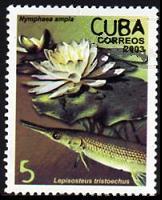 LEPISOSTEIFORMES
LEPISOSTEIFORMES LEPISOSTEIFORMES
LEPISOSTEIFORMES
| Cuba 2003 |
 |
|---|
| Cuban Gar Atractosteus tristoechus (Lepisosteidae) |
The oldest fossil of Lepisosteiformes is discovered from the stratum of the latter period for a Permian period. It develops that it was distributed widely all over the world from the record of the fossil from the Mesozoic to the Eocene epoch of the Cenozoic. Seven kinds are known, and the actual money class lives in North America, Central America, the Cuban place where it is shallow and have many waterweeds and eats brachyuran or a small fish. The body is slim, and there is the kind to become 3m. The chin sticks out of the top and bottom for a long time forward, and a lot of sharp teeth line up. There is the dorsal fin towards the back of the body. Air breathing is possible having swim bladder functioning as respiratory organs.
 NEXT
NEXT
 to Tree of Fishes
to Tree of Fishes
 to HomePage
to HomePage